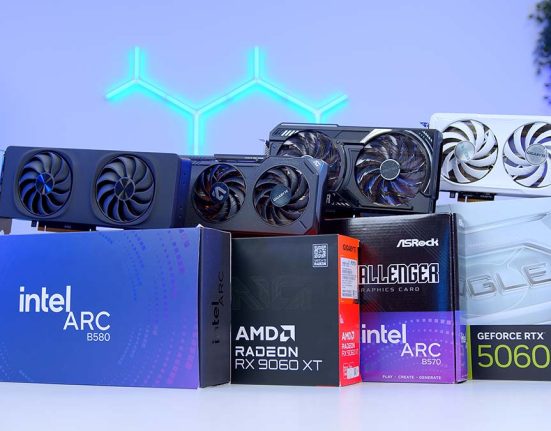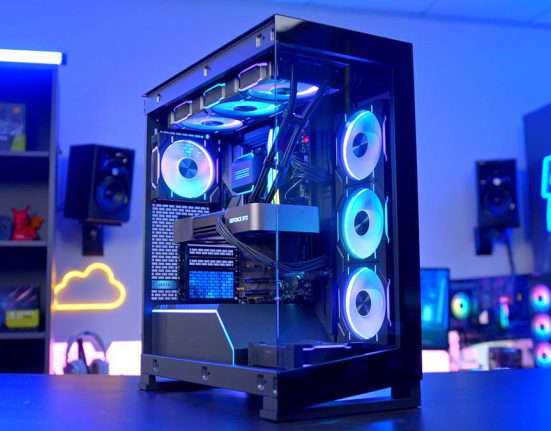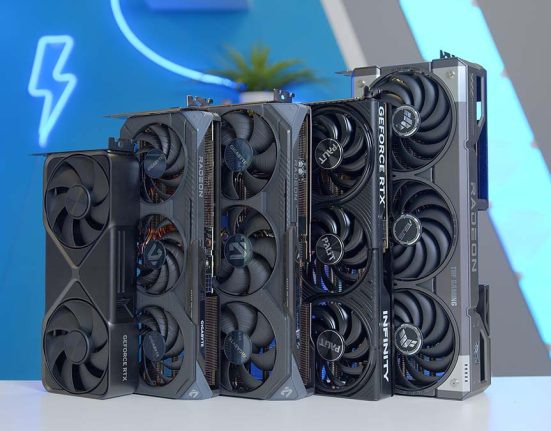When NVIDIA announces a new GPU, the world stands up and listens. The computing giant, which started life making graphics cards for gamers, is now one of the most valuable companies in the world. It generates 6x more revenue from its data centre division than it does from gaming – a truly astonishing figure when you remember that it has a whopping 88% market share in the world of gaming GPU sales.
The launch event for the RTX 50-series, aptly held in a 15,000-seat Las Vegas Arena, had as many financial analysts in attendance as gamers, with the NVIDIA share price tied almost directly to what Jensen was to discuss. Perhaps that was why the press conference went on for so long and delved into so much detail on NVIDIA’s world-beating AI models.
But that’s not what we are here to talk about today. The press conference started with the announcement of four new graphics cards on NVIDIA’s latest and greatest Blackwell GPU architecture, ranging from the flagship RTX 5090, which I’ll be reviewing in this piece, through to the cheaper and less powerful RTX 5080, RTX 5070 Ti and RTX 5070 GPUs. These cards range from $1999.99 for the RTX 5090 to just $549 for the cheapest RTX 5070 – crucially, $50 lower than the launch price of last-gen’s RTX 4070.
All four cards will land on shelves before the end of February, marking a clear departure from NVIDIA’s previous more slowly staggered launch patterns in the RTX 30 and 20 series that have come before.
The RTX 5090 is the first to land with reviewers and be on shelves for consumers to buy, which is what I’ll be reviewing today. It’s pretty conventional for the flagship card to be the first to market, showcasing everything NVIDIA’s Blackwell architecture offers in the best light possible.
Specification
The RTX 5090 has an MSRP of $1999, the same as the RTX 3090 Ti, which launched in 2022. RTX 4090 models currently sell for over $3000 new on Newegg, so it remains to be seen whether this MSRP will be a breath of relief. Scalpers may be averse to the higher launch price compared to the previous generation.

For your $1999, and potentially a good chunk of extra change, the RTX 5090 boasts a spec list as long as my left arm. You get 32GB of super-fast GDDR7 video memory, more than 21,000 CUDA cores, 680 of NVIDIA’s 5th generation Tensor Cores, 270 of NVIDIA’s 4th generation RT cores and a clock speed that surpasses 2.4GHz.
| Key Specs | RTX 5090 | RTX 4090 | RTX 4080 SUPER |
|---|---|---|---|
| Video Memory | 32GB GDDR7 | 24GB GDDR6X | 16GB GDDR6X |
| Memory Bus | 512-bit | 384-bit | 256-bit |
| Base Clock Speed | 2.29GHz | 2.23GHz | 2.29GHz |
| Boost Clock Speed | 2.55GHz | 2.52GHz | 2.55GHz |
| CUDA Cores | 21760 | 16384 | 10240 |
| RT Cores | 170 | 128 | 80 |
| Tensor Cores | 680 | 512 | 320 |
| Power Consumption | 575W | 450W | 320W |
| MSRP | $1999.99 | $1599.99 | $999.99 |
The RTX 5090’s hefty spec sheet delivers a 153% increase in AI TOPS compared to the RTX 4090, moving from 1321 to 3352. In a world where ‘AI’ is being banded around at every opportunity, you might be quick to discard this figure, but be aware that this impressive performance uplift enables NVIDIA’s latest generation DLSS 4 tech. This tech is undoubtedly one of the most important talking points of NVIDIA’s RTX 5000 series GPUs and something we’ll be covering in much more detail shortly.
Design
NVIDIA has done some really impressive things with the physical design of their RTX 5090 Founders Edition card in a bid to conclude the never-ending trend of gargantuan gaming GPUs. Compared to the last-generation RTX 4090 Founders Edition, it is a sizeably smaller design and sits comfortably inside a compact two-slot form factor. Considering this card consumes 125W more power than the RTX 4090 (575W, compared to 450W), that is nothing short of a miracle.

The way NVIDIA have achieved this is pretty extraordinary, shrinking down the PCB to a square such that it can situated in the centre of the RTX 5090. This allows the left and right sections to enable full through-airflow instead of the air being pulled in and hitting the PCB, as we have seen in GPUs for as long as I can remember.

This through-airflow makes such a big difference in temperatures that NVIDIA has been able to build a flagship GPU in a size not seen previously at this level. Aesthetically, the RTX 5090 isn’t entirely dissimilar from its RTX 4000 series counterpart. Since the RTX 3000 range, Founders Edition models have retained the angular metal look with smooth, curved edges. But instead of a contrasting silver sheen, the RTX 5090 has received the same treatment as the RTX 4000 SUPER range, adopting an all-black chassis.

Overall, I’m a fan of both the design and aesthetic. The smaller form factor approach opens up options for those looking to build Mini-ITX systems, taking up less space versus traditional builds. Stylistically, the RTX 5090 Founders Edition blends in well with dark components thanks to its sleek look.
Architecture
Alongside this new GPU architecture, NVIDIA also introduces a new generation of DLSS with version 4.0. This latest DLSS version will be exclusive to the RTX 50 series, primarily due to the extra AI TOPS needed for the latest upscaling and frame generation process, which NVIDIA says is too intensive to be easily enabled on cards from the last-generation RTX 40 series lineup.
If you’ve not heard of DLSS before, I suggest reading our DLSS breakdown for some crucial context. In short, the tech is an AI-based upscaler which uses years of machine learning (carried out on NVIDIA’s centralised supercomputers) to accurately and effectively upscale frames within games.

This allows the user to, for example, render the game on their graphics card at 720p and use AI to upscale these frames to 1080p (or to as close to native 1080p quality as possible). The advantage of this is that the performance overhead required for the upscaling is much less than the performance saving from rendering at the lower resolution, ultimately resulting in a higher average frame rate.
This tech is nothing new for NVIDIA, and with the RTX 40 series, they built on the tech further by adding ‘frame generation’ into the mix. This uses the data from two concurrent frames to render an additional frame in between. This comes at the disadvantage of marginally more latency, but it can feasibly double the frame rate in supported titles. You can find a table of just some of the supported titles below:
| Frame Generation Supported Titles |
| Cyberpunk 2077 |
| Hogwarts Legacy |
| Black Myth: Wukong |
| Ghost of Tsushima |
| Red Dead Redemption |
| Warhammer 40,000: Space Marine 2 |
| God of War Ragnarok |
| Call of Duty: Black Ops 6 |
| Star Wars Outlaws |
| Indiana Jones and the Great Circle |
| Starfield |
| The Witcher 3: Wild Hunt |
DLSS 4 takes this a step further by generating more than one frame in every two using frame generation and can render three times as many frames with a 3:1 ratio. (3 being AI-generated frames, and the 1 being the rasterised frame).
Now, this sounds exciting, and I can tell you from the demos and our testing that it is impressive. Incredibly impressive, in fact. What NVIDIA has managed to do is reduce the number of pixels being generated by order of magnitude. Previously, 100 frames per second at 1080p would have been about 207 million GPU rasterised pixels. Now, 100 frames at 1080p (assuming the use of DLSS upscaling to render at a 720p base resolution and three generated frames in every one that is rasterised) equates to just 23 million pixels.

And the difference in these figures only grows as you scale to higher and higher resolutions, such as 1440p and 4K. This results in higher frame rates across the latest AAA titles. Unlike when DLSS first launched, support is not limited to one or two games you’re unlikely to play but spans the vast majority of AAA titles and a considerable number of Steam’s top 100 games.
Fake Frames?
But all this talk of DLSS 4.0 has prompted criticism within the community at what people call ‘fake frames’. From what I can tell, the criticism stemmed from NVIDIA CEO Jensen Huang’s statement in the RTX 50 series press conference, where he equated the power of the upcoming RTX 5070 to last generation’s flagship RTX 4090. This comparison is only valid when you account for the fact the RTX 5070 has DLSS 4 support, whereas the RTX 4090 does not.

That makes the comparison objectively inaccurate in games that do not support DLSS 4, and arguably, it is too imprecise for gamers who don’t want to use DLSS 4’s most aggressive frame generation settings in their favourite titles. For this reason, we have chosen, as usual, to test a suite of games that include both DLSS support (of the 3.5 and 4 varieties this time around) and rasterisation only. For the first time in one of our reviews, we have also added detailed latency testing to inform my thoughts and conclusions about DLSS 4.0 following the performance testing section of today’s review.
Performance
As always, all of our benchmarking and testing is done by our in-house benchmarker, Harry Coleman, who has worked tirelessly to gather all the data needed for our RTX 5000 series content. The RTX 5090 and a range of competitor graphics cards have been tested in our primary benchmarking system paired up with the AMD Ryzen 7 9800X3D to provide the best framerates possible across all of the titles we tested. Speaking of which, the games featured in this benchmarking section provide a mix of AAA games and modern Esports titles to see how the RTX 5090 holds up in a range of games.
Cyberpunk 2077
Settings: 4K, Shadow Quality High, Indirect Lighting High, Reflections High, Crowd Density High, Particle Quality High, Volumetric Lighting High, Motion Blur off, GTAO Quality High, Grass Quality High, Contact Shadows High VSync Off, DLSS: On/Off, Ray Tracing: On/Off, Textures: High
Starting with Cyberpunk 2077 at 4K high settings. This benchmarking run uses no additional settings. All of the gameplay is purely rasterised. As we can see from the results, the RTX 5090 has no issues and comes out on top with a staggering 139FPS average. The RTX 4090 hit 101FPS in this benchmark, with framerates continually decreasing with the RX 7900 XTX at 79 and the RTX 4080 SUPER at 75. The RTX 5090 is supposed to handle rasterised gameplay without issues, but what happens when we switch on some extra settings?

Switching on DLSS, the RTX 5090 sees a huge uplift to 182FPS, which is about a 50FPS gain compared to the rasterised benchmark. All of the cards we tested in this run saw some solid uplifts, demonstrating the sheer power and benefit of turning on DLSS and FSR. 182FPS in Cyberpunk 2077 at 4K is incredibly smooth and a solid showing from the RTX 5090.

With Frame Gen 2x (the RTX 4000 series version of Frame Gen) and ray tracing turned on, framerates take a slight dip, but remember this is maxed-out visual fidelity. 167FPS from the RTX 5090 is incredibly strong, beating out the RTX 4090 by about 30FPS. This is the kind of difference that allows gamers to enjoy smooth monitor refresh rates without having to compromise on quality.

Alan Wake 2
Settings: 4K, Post-Processing High, Texture Resolution High, Texture Filtering High, Volumetric Lighting High, Global Illumination Quality High, Shadow Detail High, Terrain Quality High, Ray-Tracing: Enabled, Ray Tracing Preset High, DLSS: On/Off, Frame Generation: On/Off
In Alan Wake 2 at 4K high settings, the RTX 5090 outputs 90FPS, compared to the RTX 4090, which sat at 73FPS, and the RTX 7900 XTX at 63FPS. Alan Wake 2 is a fairly intense game, so switching on DLSS will uplift framerates here. Versus the previous generation cards, a 20FPS gain in rasterised gameplay is decent, but ultimately, the demand of this title is proving a bit too much without any extra settings switched on.

With ray tracing switched on, framerates are diminished further, with the RTX 5090 leading the graph with 44FPS. The intensity and optimisation of Alan Wake 2 is the primary cause of the weaker performance here, with other cards like AMD’s RX 7900 XTX and XT, this game is unplayable.

Turning on ray tracing and DLSS improves performance to a degree, but the overhead of ray tracing results in a 79FPS average from the RTX 5090. Compared to the other cards we’ve tested, the RTX 5090 is strong, but Alan Wake 2 is incredibly demanding, resulting in generally weaker frame rates compared to other games that we’ve tested.

Marvel Rivals
Settings: 4K, Graphics Quality High, Global Illumination Lumen GI- High Quality, Reflection Quality Screen Space Reflections, Model Detail High, Post-Processing High, Shadow Detail High, DLSS On/Off, Frame Gen On/Off
Throwing our first Esports title into the mix, we ran the hit title Marvel Rivals at 4K. This rasterised benchmark showcases the raw power of the RTX 5090, with an output of 142FPS on average. Generally, most of the cards we’ve tested perform pretty well in Marvel Rivals at 4K, The RTX 4090 loses out to the RTX 5090 by about 20FPS, with the RTX 4080 SUPER sitting at 89FPS. This Esports title would benefit from higher framerates to enable a smooth display experience, but this will be more feasible with DLSS or FSR switched on.

With DLSS enabled, the RTX 5090 holds firm at 167FPS, about a 20FPS gain compared to the rasterised benchmarking run. With this turned on, the RTX 4090 isn’t far behind the RTX 5090, with about 14 frames between them. We also saw a strong showing from the RX 7900 XTX in this benchmark with a 111FPS average. However, with both NVIDIA’s top-performing GPUs leading this graph by quite some margin, it’s evident that NVIDIA is a winner in this particular game.

Once Frame Gen was enabled, the RTX 5090 soared up to 248FPS. This card leaves the rest of the GPUs we tested in the dust, with the RTX 4090 losing out by about 75 frames on average. If you’re looking to enjoy super smooth framerates at 4K in Marvel Rivals, the RTX 5090 definitely won’t disappoint.

COD Black Ops 6
Settings: 4K, Graphics Preset Custom, Texture Resolution High, Depth of Field On, Detail Quality High, Particle Resolution High, Shader Quality High, Shadow Quality High, Screen Space Shadows High, DLSS On/Off, Frame Gen On/Off
In COD Black Ops 6 at 4K high settings, the RTX 5090 offered a solid average framerate of 162FPS, which is about 27 more frames than the RTX 4090. COD Zombies isn’t particularly intense, which is why the vast majority of the graphics cards that we’ve tested sat above the 100FPS mark. Overall, we were impressed with the rasterised performance across the board in this title. We did do a DLSS run but found that the percentage gain was 1-2% for most of the cards, so rasterised is the way to go.

Hogwarts Legacy
Settings: 4K Effects High, Material High, Fog High, Sky High, Foliage High, Post Process High, Shadows High, Textures High, View Distance High, Population High, Anti Aliasing TAA High, Windowed Fullscreen
Our final AAA title is Hogwarts Legacy, with the resolution dialled up to 4K high settings. In our rasterised benchmark, unsurprisingly, the RTX 5090 sits at the top of the graph with a 136FPS average. Much like Alan Wake 2, this is a rather intense title, so framerates, while relatively smooth, do suffer a little bit. The RTX 4090 offers a strong showing in this game with a 114FPS average, beyond this, framerates drop below the 100FPS mark, with the RX 7900 XTX at 95 and the RTX 4080 SUPER at 86.

With DLSS and FSR switched on without Frame Gen enabled, we see a slight uptick from the RTX 5090 up to 148FPS. In this benchmarking run, the framerate gain from the rest of the cards was more impressive, with most GPUs gaining 25-30FPS more, providing much smoother gameplay.

Finally, with NVIDIA Frame Gen enabled, framerates soared across the board, with the RTX 5090 and 4090 seeing impressive gains beyond the 200FPS mark. Ultimately, most gamers won’t ever need performance that reaches this level, but it’s cool to see regardless.

Apex Legends
Settings: 4K, Anti-aliasing TSAA, Texture Filtering 8X, Model Detail High, VSync Disabled, Effects High, Ambient Occlusion Quality High
In our penultimate game, we fired up Apex Legend at 4K, dialling the settings to high. It’s no surprise in this benchmark to see ridiculous framerates, with the RTX 5090 sitting at 293FPS. Even when Apex Legends is uncapped, its game engine only allows a max framerate of 300FPS, so we’re seeing the RTX 5090 and 4090 sit on the cusp here.
Regarding the other comparison cards that we tested, the RX 7900 XTX, RTX 4080 SUPER and RTX 4070 Ti SUPER also offered mighty performance, averaging well above the 200FPS mark.

Fortnite
Settings: 1080p, Competitive, View Distance Far, FPS Unlimited, VSync Off, Anti-Aliasing TAA, Shadows Off, Reflections Off, Textures Low
The last game that we benchmarked was Fortnite. Although we don’t really use this title to showcase competitive performance, it gives us an indicator of the generational gains between all of the cards that we’ve tested over the years. The RTX 5090 averaged 475FPS, which is around a 25FPS lead, over the RTX 4090 at 448FPS. It’s very clear that the RTX 5090 has no issues handling Fortnite at 1080p.

Conclusion
NVIDIA GeForce RTX 5090
Product Name: RTX 5090
Brand: NVIDIA
-
Features
-
Design
-
Performance
-
Value For Money
Summary
So, the performance of NVIDIA’s new GPU is laid bare and accounts for DLSS 4, Frame Generation, Ray Tracing and straight rasterisation. But where does that leave me on the ‘Fake Frames’ debate, and what are my overall thoughts on the card? Let’s start with these so-called fake frames because my conclusion rests on that. There is no doubt that frame generation adds additional latency, especially at its most aggressive 4x setting. This is a bit of a mixed bag, as in Cyberpunk 2077, we saw a 16ms increase versus 2ms in Hogwarts Legacy. That, I would argue, makes it a setting you may want to avoid in titles like Apex Legends and Fortnite, whereby latency is of utmost importance.
But, and I might be going out on a whim here, I actually think DLSS 4 is fantastic, and the latency trade-off is worth it for the increase in perceived game smoothness in the vast majority of titles. I turn the fake frames argument around and ask this: Would you rather NVIDIA added ever more VRAM and raw compute power to the GPU for, say, an extra 10% rasterisation performance or built an incredible software stack that increases efficiency and leverages centralised machined learning to deliver a far more sizeable, and far more noticeable, frame rate increase in your favourite title?
The best bit is if DLSS 1, 2 and 3 are anything to go by – DLSS 4 will only get better.
To be clear, I do want to see NVIDIA continue to deliver rasterised performance gains on a generation-by-generation basis – but it would be wrong to pretend they haven’t done this, too. The RTX 5090 delivers more performance than the RTX 4090 in our rasterised test suite and more in synthetic benchmarks too! Had the RTX 5090 been a repackaged RTX 4090 that only added the extra AI compute needed for DLSS 4 support, I would have been disappointed. But it isn’t, and the frenzy around fake frames frankly feels like it has gone a little far. NVIDIA’s software and hardware stack continues getting better, and if (and it’s a BIG if), the superb performance of the RTX 5090 is to set the tone for the remainder of the RTX 5090 lineup, AMD should be even more worried than they were just a few months back.
Pros
✅ Performance vs 4090
✅ Multi-frame gen
✅ Smaller form factor
Cons
❌ Expensive
❌ Latency with multi-frame gen
❌ Power hungry


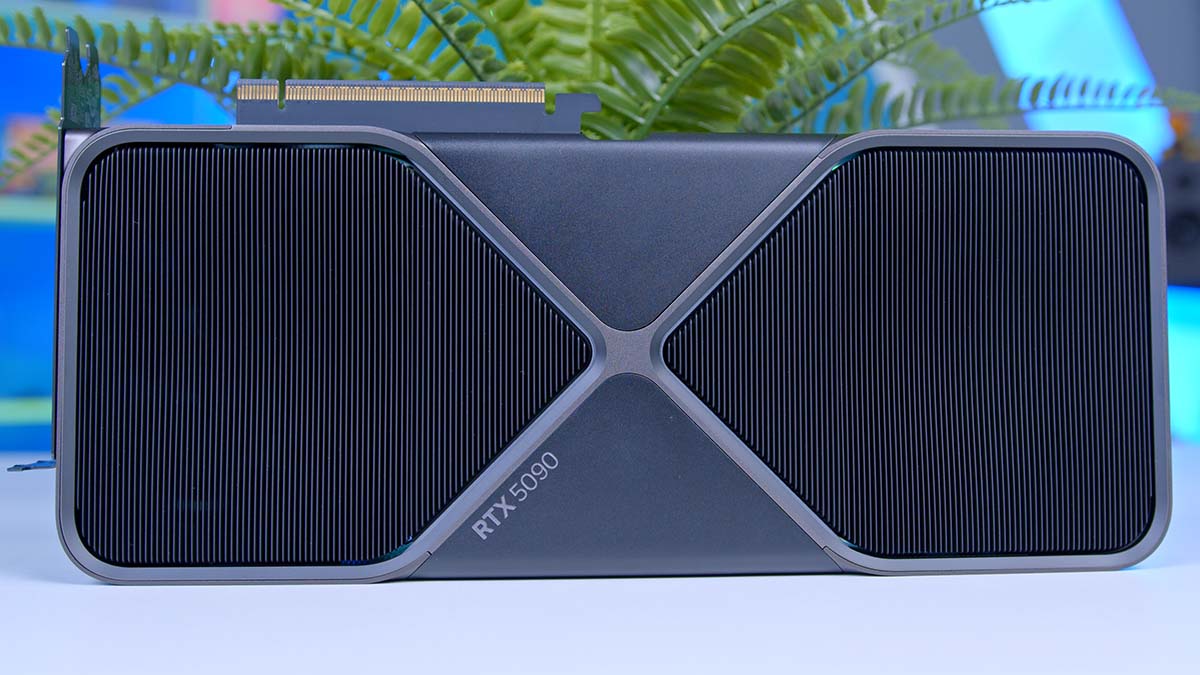
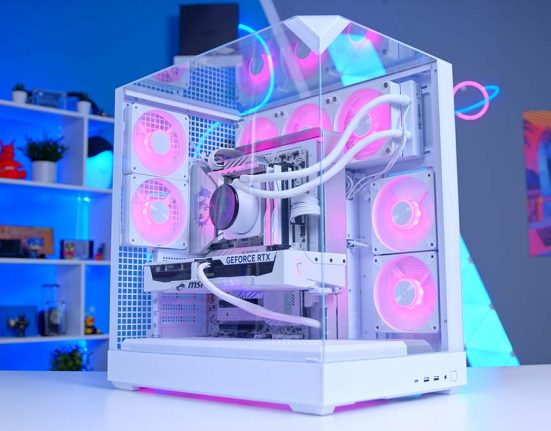
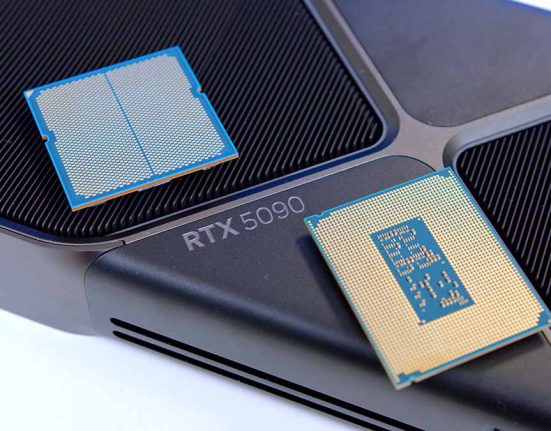
![FI_[DM76] HAVN BF360 5090 Build](https://geekawhat.com/wp-content/uploads/2025/10/FI_DM76-HAVN-BF360-5090-Build-1-551x431.jpg)
